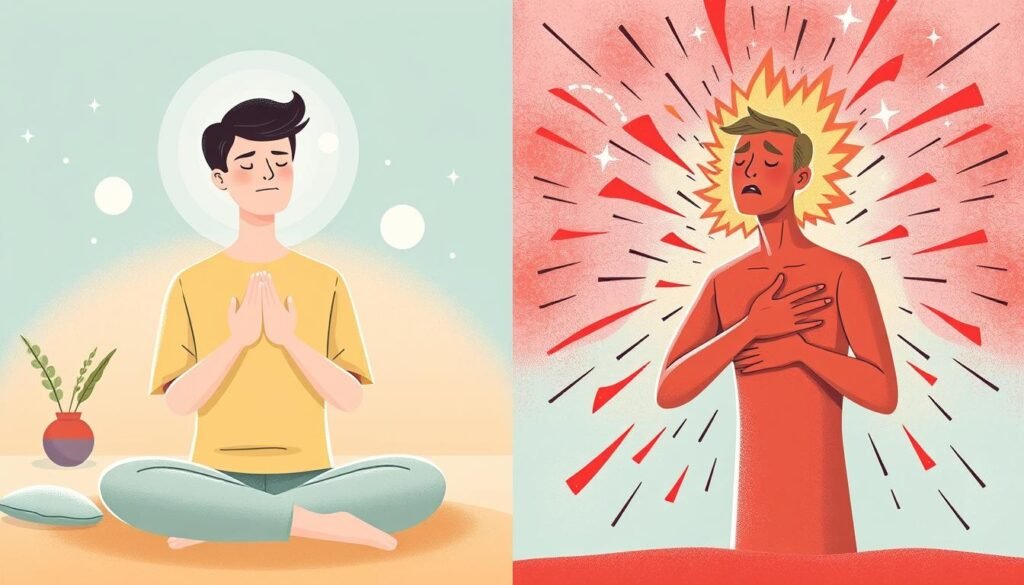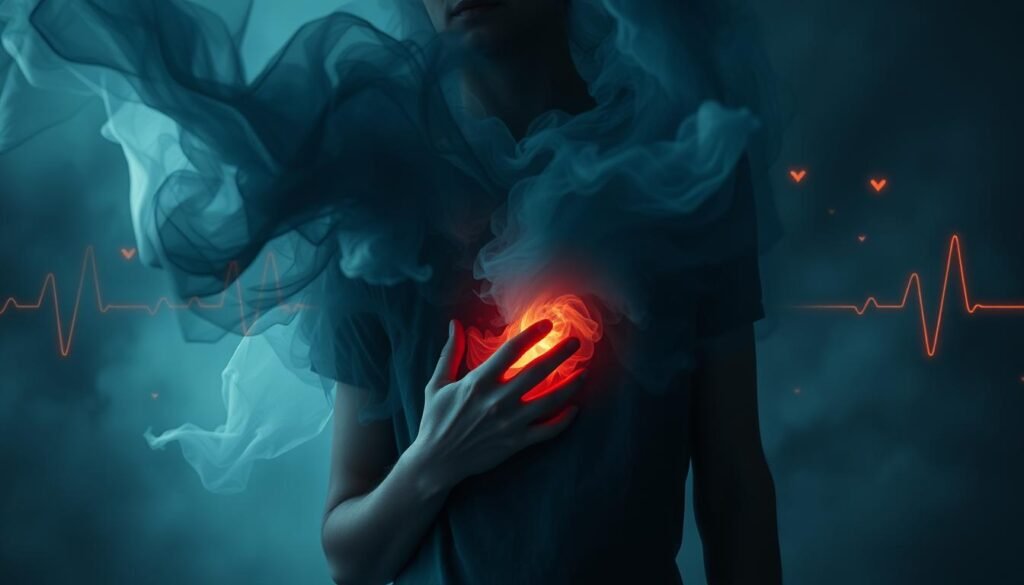Ever felt a sudden tightness in your chest and wondered if it’s anxiety or something else? Many people get confused when they feel chest tightness anxiety. It’s a mix of physical pain and emotional stress. Knowing how anxiety symptoms show in the body is key to finding relief tips that work.
We’ll cover the causes, symptoms, and best ways to handle chest tightness from anxiety. You’ll learn how to tell apart anxiety from heart problems. We’ll also look at solutions like meds, therapy, and self-care. Knowing when to get professional help is crucial for getting the right support fast.
Key Takeaways
- Anxiety symptoms can mimic heart issues, often leading to confusion.
- Recognizing signs of a panic attack can help distinguish between anxiety and other health problems.
- Breathing exercises and mindfulness meditation are powerful coping strategies.
- Journaling can clarify anxious thoughts and reduce stress.
- Seeking professional support through therapy and medication can greatly improve management of anxiety disorders.
For folks dealing with anxiety and chest tightness, it’s important to understand this issue. There are resources out there to help on your path to feeling better.
Understanding Chest Tightness and Anxiety
Chest tightness can signal a deeper issue, often tied to anxiety. Anxiety can make your body show physical signs. Things like muscle tension in your chest happen. This relationship between anxiety and chest tightness shows up when stress starts the body’s fight-or-flight response. This can feel scary and uncomfortable.
Many people who go to the ER with chest pain don’t have heart issues. Studies show 30-40% have chest pain from anxiety. So, it’s key to understand anxiety to figure out these symptoms. This helps in managing them effectively.
When anxious, you might have a fast heartbeat and more adrenaline. These can look a lot like heart problem symptoms. Dizziness, feeling out of breath, and heart flutters add to the mix-up. Knowing these signs are from anxiety is crucial.
To ease the discomfort, try some solutions. Deep breaths and focusing on the moment can fight anxiety chest tightness. If you’re dealing with this, get advice and a check-up to find the right help. For more help on handling these issues, check out this resource.
What Causes Chest Tightness Anxiety?
Chest tightness from anxiety is linked to our body’s stress reaction. This happens when we feel threatened. Adrenaline and cortisol are released, increasing heart rate and muscle tension. This leads to a pressured feeling in the chest. People often think it signals a heart problem.
About 30% of adults will face an anxiety disorder in their lifetime. These are the most common mental health issues. Generalized Anxiety Disorder (GAD) involves long-term worry. Panic Disorder causes intense fear and chest tightness. Social Anxiety Disorder and phobias also make anxiety worse, including chest tightness.
Long-term anxiety keeps muscles tense, making chest tightness worse. Sufferers may also have rapid breathing and a fast heartbeat. Cognitive behavioral therapy (CBT) is effective in treating these symptoms. It helps reduce the chest tightness linked to anxiety.
Knowing the root causes of chest tightness due to anxiety is key to managing it. Realizing anxiety causes this discomfort helps us find the right coping strategies. It also guides us to seek professional help when needed.
Symptoms of Chest Tightness Anxiety
Chest tightness anxiety can show up in many ways. People may feel sharp or dull chest pain that comes and goes. It usually lasts about 10 minutes. This discomfort can be scary, more so when paired with chest pain anxiety symptoms like a fast heartbeat, sweating, or trouble breathing.
Anxiety triggers a stress response, raising adrenaline and cortisol levels. This reaction can cause chest pain. It also leads to muscle tension and sweating. Feeling faint, shaking, and a pounding heart can make chest tightness worse. It’s important to know these are anxiety signs, not always serious health issues.
Distinguishing anxiety chest tightness from other conditions is critical. For instance, heart attack symptoms usually start with physical effort, while anxiety-related discomfort can pop up suddenly, even in calm moments. Recognizing these chest pain anxiety symptoms helps manage anxiety. It also reduces fear about what these feelings mean.
Chest Tightness vs. Heart Attack: Key Differences
Knowing how to tell chest tightness apart from a heart attack is essential. A heart attack usually starts with intense chest pain spreading to arms, jaw, or back. This pain grows stronger over time. On the other hand, anxiety might cause chest tightness that feels sharp but short-lived.

- Shortness of breath
- Nausea or vomiting
- Lightheadedness
- Extreme sweating
- A feeling of impending doom
Panic attacks focus on the chest and don’t last long. They might feel intense but fade within an hour. Notice these heart attack signs:
| Heart Attack Symptoms | Panic Attack Symptoms |
|---|---|
| Chest pain or pressure | Chest pain |
| Pain radiating to arms, jaw, or neck | Pain remains primarily in the chest |
| Shortness of breath | Difficulty breathing |
| Lightheadedness | Weakness or dizziness |
| Nausea | Stomach pain |
| Tachycardia, rapid heart rate | Tachycardia, racing heart |
Understanding these differences is key to getting help fast. Stress affects both, yet panic attacks have clear emotional causes. Being aware of these signs helps avoid panic and ensures we get help when it’s truly needed.
Recognizing the Signs of a Panic Attack
Panic attacks show up with clear symptoms that need attention. One common sign is sudden chest tightness. This is often joined by intense fear, like fearing death or losing control.
Common panic attack symptoms can include:
- Heart palpitations or racing heart
- Trembling or shaking
- Sweating
- Shortness of breath or feeling smothered
- Stomach pain or nausea
- Chills or hot flashes
- Numbness or tingling sensations
Panic attack symptoms usually last between 10 to 20 minutes. But, some feelings may stick around longer. Knowing these signs helps people manage better during such episodes. Anxiety can make chest tightness worse, causing more stress.
Anxiety attacks are different from panic attacks. They can last longer, even weeks. Counseling and changing behaviors help those who often face panic attacks. Understanding their symptoms lets people handle tough times better. It also guides them to get the help they need.
Knowing how to spot panic attack signs is vital. It helps people tell the difference between anxiety and more severe health issues. If symptoms worsen or new ones appear, it’s smart to get medical help to check things out.
Chest Tightness Anxiety: How It Feels
Chest tightness anxiety shows up in many ways. It makes people feel uncomfortable and worried. Many describe it as a sharp pain. Knowing about these different feelings helps people understand their symptoms better. This way, they can find better ways to deal with anxiety.
Common Descriptions of Anxiety-Related Chest Pain
People describe anxiety chest pain differently. Some common descriptions are:
- Sharp or stabbing pain that comes on suddenly.
- Pressure or heaviness that leads to tightness.
- Aching sensation in the chest that is easy to confuse with serious problems.
Studies show that 58% of chest pain from anxiety is not heart-related. This fact is crucial. It helps tell apart anxiety pain from other health issues. Most of the time, this pain is in the chest’s center or left side. Unlike heart attack pain, it does not spread to other areas.
Physical and Emotional Responses to Anxiety
Physical and emotional responses make chest tightness worse. Key reactions include:
- Muscle tension in the chest and shoulders, adding to the pain.
- Shortness of breath, making panic worse.
- Feelings of panic or doom, making symptoms feel more intense.
Learning to handle these reactions is key. Relaxation methods like meditation help. So does understanding anxiety and seeking expert advice. For extra help, check out this resource.

| Response Type | Physical Symptoms | Emotional Symptoms |
|---|---|---|
| Chest Pain | Sharp, stabbing | Panic, dread |
| Breathing Difficulties | Shortness of breath | Feeling overwhelmed |
| Muscle Tension | Chest and shoulder tightness | Fear, anxiety |
Knowing how to respond to these signs helps people manage anxiety. This can reduce their chest tightness distress.
Coping Strategies for Chest Tightness Anxiety
Feeling chest tightness because of anxiety is tough. It’s important to learn how to cope with these feelings. People can try breathing and being mindful to get relief. These methods can give immediate comfort and lessen anxiety with time.
Breathing Exercises for Immediate Relief
Breathing exercises work well for easing anxiety. Trying box breathing and pursed lip breathing helps control your breathing. It makes you feel relaxed. Let’s look at a couple of techniques:
- Box Breathing: Breathe in for four counts, hold for four, breathe out for four, and hold again. This pattern can calm you down.
- Pursed Lip Breathing: Breathe in slowly through the nose, then out through lips like you’re blowing a candle. It slows down your breathing and helps with the tightness.
Mindfulness Techniques to Manage Anxiety
Using mindfulness can really help with anxiety and chest tightness. It’s about staying in the now, which can make you feel less overwhelmed. Here are some good ways to do it:
- Mindfulness Meditation: Take a few minutes daily to shut your eyes, breathe deeply, and just notice your thoughts and feelings without judging them.
- Grounding Techniques: Try the 5-4-3-2-1 method. Notice five things you see, four you can touch, three you hear, two you smell, and one you can taste. It shifts your focus from anxiety.
Using these strategies can really help someone handle their anxiety and chest tightness. By practicing regularly, you can get stronger in facing anxiety in daily life. This leads to a calmer existence.
Stress Management Techniques to Alleviate Symptoms
Managing anxiety can be easier with certain stress management techniques. They help ease symptoms like chest tightness. Journaling for anxiety and exercising are two effective methods. They boost emotional stability and physical health.
Journaling for Clarity and Relief
Journaling lets people express thoughts and feelings. It leads to clearer understanding and emotional relief. Writing about life helps organize thoughts and lessen anxiety.
This method provides a safe space for emotions. It has become essential for many in handling stress. It helps them understand their feelings better.
Exercise: A Natural Anxiety Reducer
Regular exercise is key in managing stress. Activities like walking, yoga, or tai chi bring calmness. They also release endorphins, improving mood.
Many find that a quick walk reduces anxiety and enhances focus. It’s a natural way to feel better.
| Stress Relief Technique | Benefits | Typical Audience |
|---|---|---|
| Deep Breathing | Reduces heart rate, alleviates anxiety | Individuals experiencing stress symptoms |
| Music Therapy | Improves mood, provides quick relief | People seeking emotional support |
| Walking | Enhances focus, alleviates tension | Those feeling overwhelmed |
| Outdoor Sun Exposure | Lifts spirits, combats feelings of depression | Individuals needing emotional boosts |
| Hand Massage | Instant relaxation, relieves tension | Individuals seeking quick stress relief |
| Foot Massage | Stress reduction, relaxation | Those looking for soothing techniques |
| Using Stress Balls | Tension release, effective distraction | Anyone facing stress-inducing situations |
Adding these stress management techniques to your routine can help fight anxiety. Using methods like journaling and exercise improves mental and physical health. They empower you to cope better with stress.
When to Seek Professional Help for Anxiety Symptoms
An estimated 40 million Americans deal with an anxiety disorder. It’s key to know when you should seek professional help. Severe or frequent symptoms mean it’s time to see a healthcare provider. If anxiety stops you from living your life, finding support is smart.
Persistent chest pain shouldn’t be ignored as it can be worrying. Chest tightness is common in panic attacks and feels overwhelming. If this happens, decide if your symptoms are from anxiety or something more serious, like COVID-19 or heart issues.
Knowing when to visit a doctor is crucial. Look out for:
- Severe anxiety that stays.
- Continuing chest pain or other serious symptoms.
- Problems at work or in personal relationships due to anxiety.
- Bad effects from panic attacks on your health.
There are treatments available, including SSRIs and benzodiazepines that help manage anxiety. Adding regular exercise helps too. Deep breathing and cognitive behavioral therapy (CBT) provide strong support.
Understanding these tips can help people take action. Don’t wait to seek help if anxiety gets too much. Getting help early leads to better treatment and a happier life.
Therapy Options for Managing Chest Tightness Anxiety
Dealing with anxiety that causes chest tightness means trying different therapies. Cognitive-behavioral therapy (CBT) is popular for changing harmful thought patterns linked to anxiety. Medicines for anxiety can also be very helpful in easing symptoms. Knowing about the various therapies and medicines can help people better manage their condition.
Types of Therapy Available
There are many helpful therapies for easing anxiety symptoms, including:
- Cognitive Behavioral Therapy (CBT): Aims to shift negative thoughts and actions.
- Mindfulness Sessions: Helps focus on the present to lessen anxiety’s impact.
- Relaxation Training: Offers techniques like deep breathing to lower stress.
- Exposure Treatment: Slowly gets people used to what makes them anxious in a safe way.
Medication Considerations for Anxiety Disorders
Some people might need medication for severe anxiety symptoms. Selective serotonin reuptake inhibitors (SSRIs) are often chosen and can balance mood. It’s important to talk with a healthcare provider about medicine to make sure it fits an individual’s needs.

Conclusion
Understanding chest tightness from anxiety is key. It helps us know the signs and how to ease them. The article covered symptoms like pressure, pain, and breathing difficulties. Knowing these can help tell apart anxiety from serious health issues. This knowledge is crucial for better managing our health.
There are many ways to deal with anxiety. Breathing exercises and mindfulness help calm and reduce stress. But, if the symptoms don’t go away, it’s important to ask for professional help. Therapy, like Cognitive Behavioral Therapy, can change negative thinking and boost well-being.
The journey to overcome chest tightness caused by anxiety has many steps. It combines self-help methods and professional support. By recognizing anxiety signs and using effective strategies, people can take back control of their lives. Learning and using these resources leads to stronger emotional health and better management of anxiety.